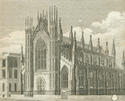 In the late 1700s, after centuries of persecution and ostracisation, Catholics in Glasgow could be numbered in tens rather than hundreds. The industrial revolution changed that, bringing first Catholic highlanders, then, in the early 1800s, Irish immigrants to Glasgow.
In the late 1700s, after centuries of persecution and ostracisation, Catholics in Glasgow could be numbered in tens rather than hundreds. The industrial revolution changed that, bringing first Catholic highlanders, then, in the early 1800s, Irish immigrants to Glasgow.
 The Irish Famine (1845-50) saw a massive influx of Irish immigrants to the city in the middle of the 19th century. Largely, though not exclusively, Catholic, these poor families were to change the face and character of their adoptive city.
The Irish Famine (1845-50) saw a massive influx of Irish immigrants to the city in the middle of the 19th century. Largely, though not exclusively, Catholic, these poor families were to change the face and character of their adoptive city.
 St Andrew's Cathedral in Clyde Street was the welcome first sight to greet many a Catholic immigrant arriving to begin a new life. Yet even when it was being built anti-Catholic prejudice was so strong that the bricks laid by day would be kicked down by night.
St Andrew's Cathedral in Clyde Street was the welcome first sight to greet many a Catholic immigrant arriving to begin a new life. Yet even when it was being built anti-Catholic prejudice was so strong that the bricks laid by day would be kicked down by night.
 The normal structures of the Catholic Church were absent at that time. It was only in 1878 that normal ecclesiastical governance was restored. Charles Eyre, a Yorkshireman, was named Archbishop of Glasgow that year - the first for 275 years.
The normal structures of the Catholic Church were absent at that time. It was only in 1878 that normal ecclesiastical governance was restored. Charles Eyre, a Yorkshireman, was named Archbishop of Glasgow that year - the first for 275 years.
 By the early 20th century Catholics were numerically a large sub-section of Glasgow's population, with their own self-funded schools, churches and social traditions. It was to take their loyalty and courage during the dark hours of World War One, however, to ensure even their partial acceptance as fully-paid up Glaswegians by some of their fellow citizens.
By the early 20th century Catholics were numerically a large sub-section of Glasgow's population, with their own self-funded schools, churches and social traditions. It was to take their loyalty and courage during the dark hours of World War One, however, to ensure even their partial acceptance as fully-paid up Glaswegians by some of their fellow citizens.
So it was that in the years 1830-1914, Catholicism in Glasgow developed from the barely tolerated devotion of the few to the widely-practiced faith of the many.